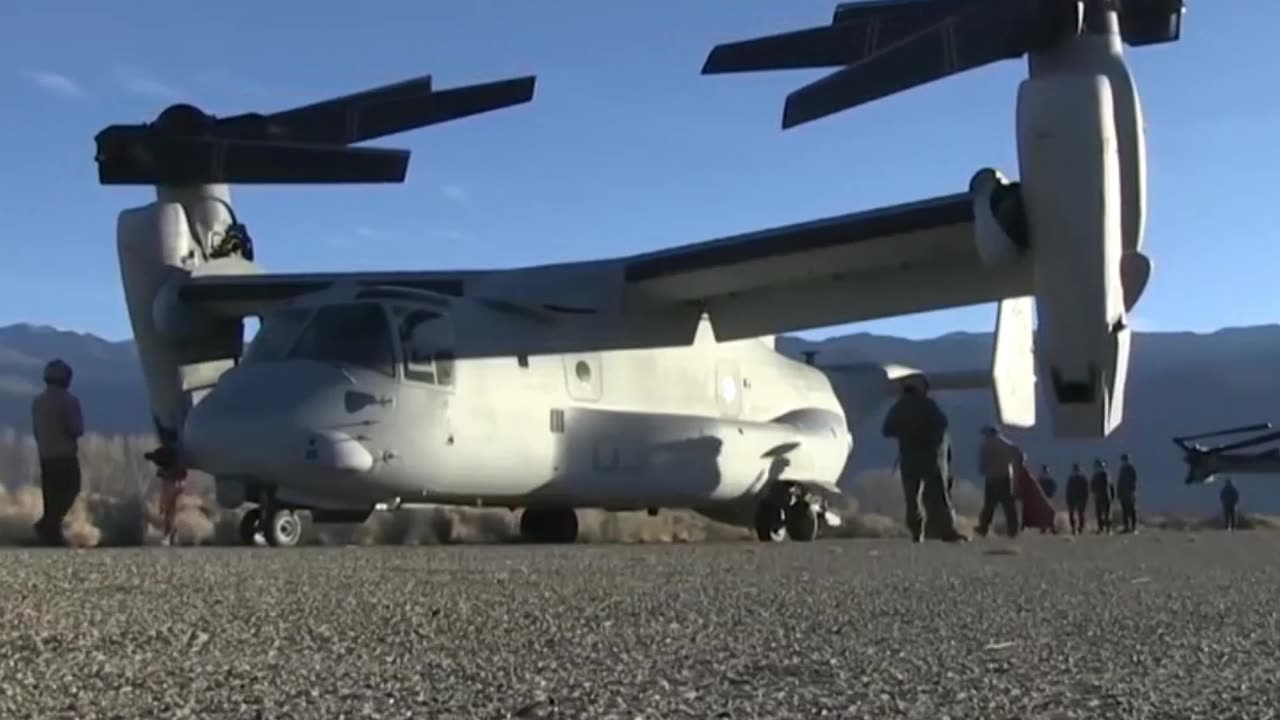Premium Only Content

MV-22 Osprey Unfold The Wings and Rotor Blades
The Bell Boeing V-22 Osprey is an American multi-mission, tiltrotor military aircraft with both vertical takeoff and landing (VTOL) and short takeoff and landing (STOL) capabilities. It is designed to combine the functionality of a conventional helicopter with the long-range, high-speed cruise performance of a turboprop aircraft.
In 1980, the failure of Operation Eagle Claw (during the Iran hostage crisis) underscored that there were military roles for which neither conventional helicopters nor fixed-wing transport aircraft were well-suited. The United States Department of Defense (DoD) initiated a program to develop an innovative transport aircraft with long-range, high-speed, and vertical-takeoff capabilities, and the Joint-service Vertical take-off/landing Experimental (JVX) program officially commenced in 1981. A partnership between Bell Helicopter and Boeing Helicopters was awarded a development contract in 1983 for the V-22 tiltrotor aircraft. The Bell Boeing team jointly produces the aircraft. The V-22 first flew in 1989 and began flight testing and design alterations; the complexity and difficulties of being the first tiltrotor for military service led to many years of development.
The United States Marine Corps (USMC) began crew training for the MV-22B Osprey in 2000 and fielded it in 2007; it supplemented and then replaced their Boeing Vertol CH-46 Sea Knights. The U.S. Air Force (USAF) fielded its version of the tiltrotor, the CV-22B, in 2009. Since entering service with the Marine Corps and Air Force, the Osprey has been deployed in transportation and medevac operations over Iraq, Afghanistan, Libya, and Kuwait. The U.S. Navy planned to use the CMV-22B for carrier onboard delivery duties beginning in 2021.
The Osprey is the world's first production tiltrotor aircraft, with one three-bladed proprotor, turboprop engine, and transmission nacelle mounted on each wingtip. It is classified as a powered lift aircraft by the Federal Aviation Administration. For takeoff and landing, it typically operates as a helicopter with the nacelles vertical and rotors horizontal. Once airborne, the nacelles rotate forward 90° in as little as 12 seconds for horizontal flight, converting the V-22 to a more fuel-efficient, higher speed turboprop aircraft.[102] STOL rolling-takeoff and landing capability is achieved by having the nacelles tilted forward up to 45°.[103][104] Other orientations are possible.[105] Pilots describe the V-22 in airplane mode as comparable to the C-130 in feel and speed. It has a ferry range of over 2,100 nmi. Its operational range is 1,100 nmi.
Composite materials make up 43% of the airframe, and the proprotor blades also use composites. For storage, the V-22's rotors fold in 90 seconds and its wing rotates to align, front-to-back, with the fuselage. Because of the requirement for folding rotors, their 38-foot (11.6 m) diameter is 5 feet (1.5 m) less than would be optimal for an aircraft of this size to conduct vertical takeoff, resulting in high disk loading. Most missions use fixed wing flight 75% or more of the time, reducing wear and tear and operational costs. This fixed wing flight is higher than typical helicopter missions allowing longer range line-of-sight communications for improved command and control.
Exhaust heat from the V-22's engines can potentially damage ships' flight decks and coatings. NAVAIR devised a temporary fix of portable heat shields placed under the engines and determined that a long-term solution would require redesigning decks with heat resistant coating, passive thermal barriers, and ship structure changes. Similar changes are required for F-35B operations. In 2009, DARPA requested solutions for installing robust flight deck cooling. A heat-resistant anti-skid metal spray named Thermion has been tested on USS Wasp.
Boeing is developing a roll-on/roll-off aerial refueling kit, which would give the V-22 the ability to refuel other aircraft. Having an aerial refueling capability that can be based on Wasp-class amphibious assault ships would increase the F-35B's strike power, removing reliance on refueling assets solely based on large Nimitz-class aircraft carriers or land bases. The roll-on/roll-off kit can also be applicable to intelligence, surveillance and reconnaissance (ISR) functions. Boeing funded a non-functional demonstration on a VMX-22 aircraft; a prototype kit was successfully tested with an F/A-18 on 5 September 2013.
The high-speed version of the hose/drogue refueling system can be deployed at 185 knots (213 mph; 343 km/h) and function at up to 250 knots (290 mph; 460 km/h). A mix of tanks and a roll-on/roll-off bladder house up to 12,000 lb (5,400 kg) of fuel. The ramp must open to extend the hose, then raised once extended. It can refuel rotorcraft, needing a separate drogue used specifically by helicopters and a converted nacelle. Many USMC ground vehicles can run on aviation fuel; a refueling V-22 could service these. In late 2014, it was stated that V-22 tankers could be in use by 2017, but contract delays pushed IOC to late 2019. As part of a 26 May 2016 contract award to Boeing, Cobham was contracted to adapt their FR-300 hose drum unit as used by the KC-130 in October 2016. While the Navy has not declared its interest in the capability, it could be leveraged later on.
-
 53:47
53:47
Matt Kohrs
3 hours agoLIVE! Nvidia Earnings Call || NVDA Stock Reaction
18K1 -
 32:25
32:25
Tudor Dixon
1 hour agoKarol Markowicz on Freedom, Immigration, and Saving the American Dream | The Tudor Dixon Podcast
51 -
 2:03:25
2:03:25
The Quartering
5 hours agoFlag Burning, Free Speech, Church Attack & More With Andrew Wilson
187K297 -

The Robert Scott Bell Show
19 hours agoDr. Peter McCullough, Vaccines: Mythology, Ideology, and Reality, Dr. Dan Sullivan, Chiropractic - The RSB Show 8-27-25
18K -
 1:21:03
1:21:03
Darkhorse Podcast
5 hours agoFreedom, Tyranny, and Childhood Lost: The 291st Evolutionary Lens w/ Bret Weinstein & Heather Heying
34.2K17 -
 LIVE
LIVE
LFA TV
11 hours agoLFA TV ALL DAY STREAM - WEDNESDAY 8/27/25
1,326 watching -
 2:34:01
2:34:01
Steven Crowder
5 hours agoBREAKING: Minnesota Catholic School Shooting Update - Shooter & Manifesto
319K494 -
 42:22
42:22
Stephen Gardner
2 hours ago🚨CHICAGO Mayor PISSED as Residents BEG Trump to send National Guard
23.4K8 -
 1:17:28
1:17:28
The HotSeat
3 hours agoChristian School Shooting in Minnesota – Faith Under Fire & Prophecy Being Fulfilled
15.6K18 -

Film Threat
18 hours agoPEACEMAKER BLOWS GUNN'S DC! PLUS ALIEN: EARTH AND DEXTER RESURRECTION | Hollywood on the Rocks
9.5K